On 24 August 2020, train 6A11 − the Robeston to Theale freight train − derailed near Llangennech, Carmarthenshire. Of its 25 bogie tank wagons, each carrying 75.5 tonnes of petroleum products, 10 were derailed. This resulted in the spillage of 446,000 litres of oil and a major fire.
Although no-one was hurt, this was a major environmental incident with 330,000 litres of oil draining into the surrounding wetlands which is a both a site of special scientific interest and a special area of conservation. The extensive damage to the track and the underlying formation, and the need to remove contaminated soil, meant that the route was not reopened until 5 March 2021.
The RAIB report into the incident was released on 13 January 2022. Its comments about freight wagon maintenance are salutary reading.
Before the derailment
Train 6A11 left Robeston, near Milford Haven at 2152. Its class 60 locomotive and 25 laden bogie tank wagons had a combined weight of 2,672 tonnes. It travelled 62 miles at speeds of up to 60mph before it was derailed at Morlais Junction. Signallers at signal boxes enroute did not report anything untoward as the train passed. However, CCTV recording shows sparks from the third wagon’s front wheelset at Pen-y-bedd level crossing which is 11.5 miles from Morlais Junction. The train passed this crossing at 2246.
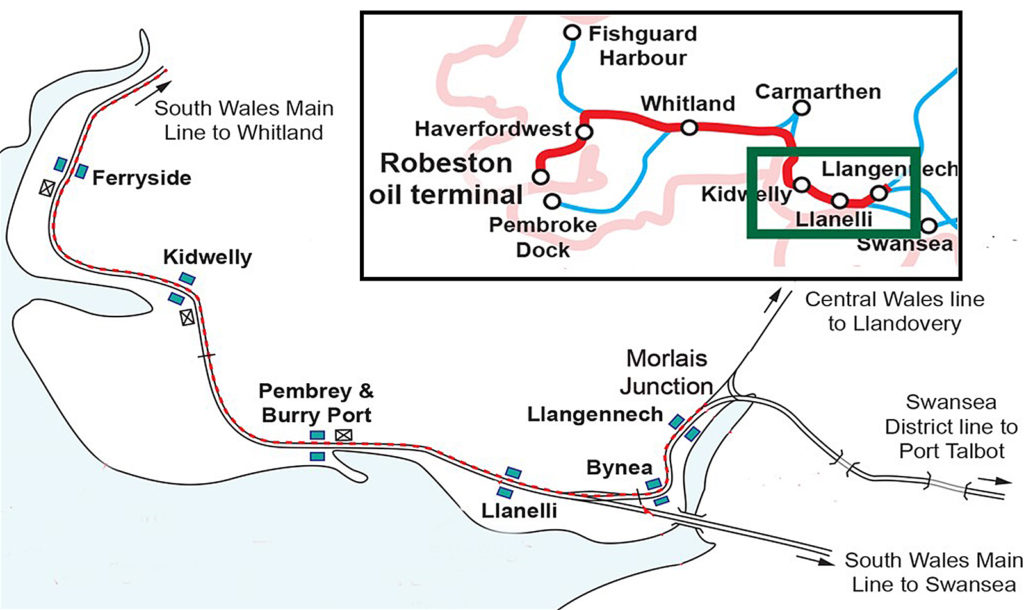
At 2250, 6A11 passed through Pembrey station where members of the public reported hearing unusual ‘metal on metal’ sounds and then passed over the hot axle box detector system (HABD) at Pembrey, which did not generate an alarm.
As the train passed through Llanelli station at 2253, CCTV also recorded heavy sparking from the third wagon’s front wheelset. At Llangennech station, half a mile before derailment, it left marks on the railhead of the type associated with locked wheels. When the train reached Morlais Junction it was travelling at 38mph.
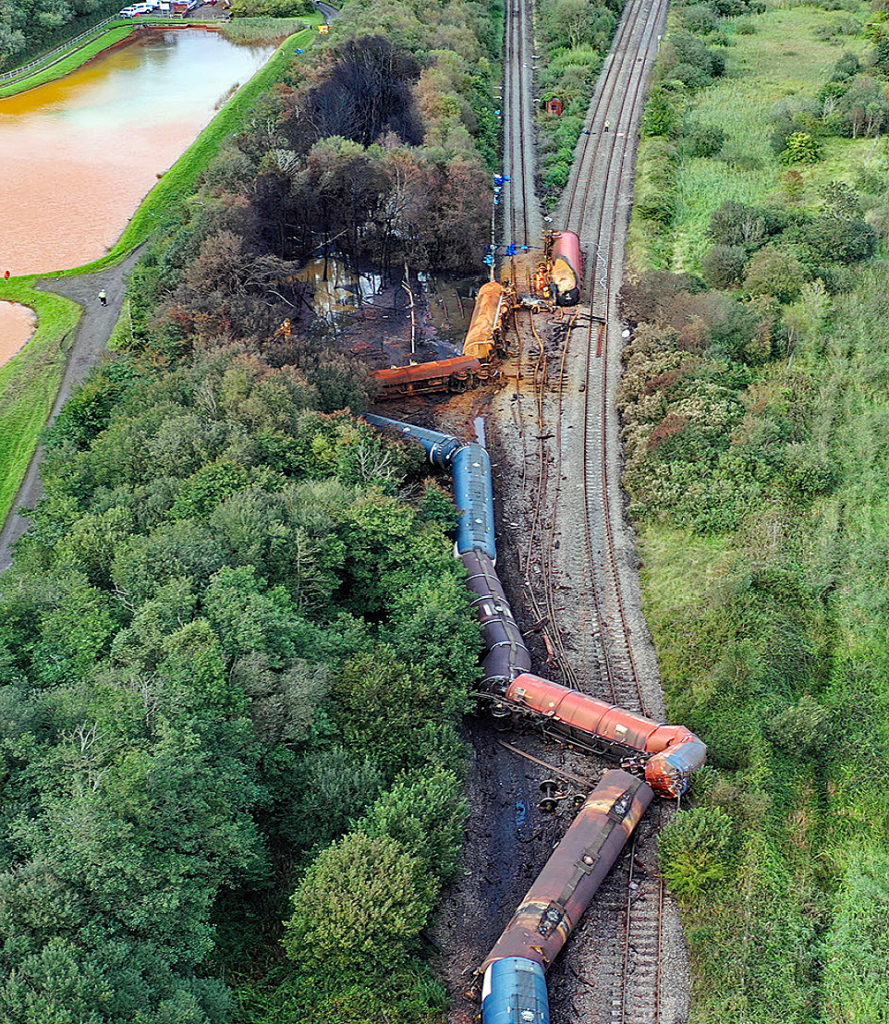
As the third wagon − TEA wagon GERS 89005 − reached the junction’s trailing points, it derailed to the left as its leading wheelset had a false flange from sliding on the rail. Shortly afterwards, this derailed wagon and those behind it were diverted to the left at the facing points causing the derailment of wagons behind it. This also broke the coupling and brake pipe between the second and third wagons and applied the train brake. Of 10 derailed wagons, five overturned, six were punctured. Wagons three, four, and five also caught fire.
Loose nuts
The RAIB investigation concluded that the derailment was caused by the false flange on the leading wheelset of wagon GERS 89005. The report found that the false flange was the result of the wheelset ceasing to rotate and that this was ‘probably’ caused by a braking system malfunction.
RAIB defines the term ‘probably’ to mean a highly likely conclusion with some element of uncertainty remaining. In this case, due the fire and damage, RAIB was unable to forensically prove that there had been a brake malfunction. However, the report rules out all other possibilities. Hence it is reasonable to consider that this accident was due to a braking system malfunction.
The investigation considered other potential factors of track geometry, the preparation and driving of the train, and a failure of the brake relay valve, and found no evidence that these were contributary factors.
RAIB investigators found that on wagon GERS 89005, the nuts securing the brake relay valve were loose with no washers present and that the mounting studs in the pipe bracket were only finger tight. As a result, the mating faces between this valve and pipe bracket had separated by one to two millimetres. The resultant displacement of ‘O’ rings then created a route for air to flow between the relay valve’s input and output ports to produce a partial brake application which ultimately locked the front wheelset.

The report considered the loose relay valve was due to two sub-factors: (i) a relay valve design change that increased the risk of it becoming loose; and (ii) the valve not being maintained as specified by the manufacturer.
The brake relay valve was originally fitted to the mating surface of the pipe bracket by four M8 (8mm diameter) studs. However, around 1985, this design was changed to reduce the number of studs from four to two, with the studs and nuts increased to M10 size. The braking system was designed by SAB Wabco who also introduced this modification. Subsequently, they became Wabtec Faiveley who had no documentation of a risk assessment for this design change.
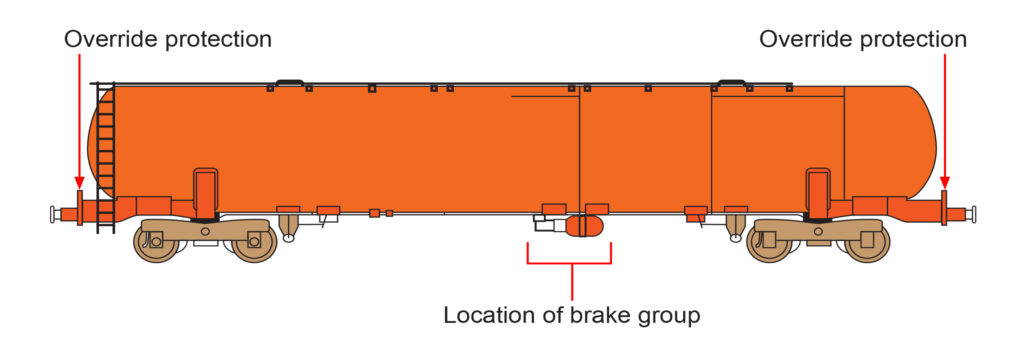
After tests and analysis, RAIB concluded that the design change from four to two fasteners had resulted in an inherently higher risk as, if one fastener was not fully tightened, the joint would tend to rotate around the remaining stud and loosen it. Some engineers consider that it is the nut and bolt that prevents the joint from moving, but they misunderstand how bolted joints work. RAIB considered this in its investigation into the 2007 Grayrigg derailment which was also due to loose nuts, in this case on a set of points. The explanatory ‘Bolted Joints’ box is based on appendix E from that report.
Another design issue with this joint is securing ‘O’ rings as they are installed. These ‘O’ rings make the seals between the various compressed air passages on the mating surface. When the relay valve is fastened to the pipe bracket it is vertically orientated, so the ‘O’ rings have somehow to be held in place while the valve is fitted. RAIB reported that standard practice was to hold ‘O’ rings in place with dabs of grease. However, a good bolted joint requires the mating faces to be clean and grease free (refer Box). This is clearly a conflict. Moreover, maintenance often happens in the open, sometimes in poor weather and lighting, making it difficult for maintainers to ensure everything is properly done.


Bolted joints
When tightening a threaded fastener, the torque used extends the length of the bolt or stud under tension as surfaces are clamped together. The resultant longitudinal tensile force in the bolt is known as the preload. The reaction to this force results in a clamping force within the joint. In the case of the relay valve, part of this preload compresses the ‘O’ rings to achieve air-tight seals.
Some of the tightening torque is used in overcoming the friction both between the threads of the nut and the bolt/stud, and between the nut and the clamped part with which it is in contact. For steel components, the coefficient of friction typically ranges between 0.1 and 0.445. For the threads, the amount of friction is dependent upon its condition which generally deteriorates with reuse and retightening, and any lubrication or contamination present. For a given torque, higher thread friction results in less preload, and hence less clamping force within the joint.
The failure of a joint can be defined as slip. Slip occurs when the load on the joint exceeds its clamping force and allows the joint surfaces to separate or move relative to each other. For the brake relay valve on GERS 89005, the vertical load is the weight of the valve flexed by the dynamic impact of vibration. In this case, deterioration of the ‘O’ rings will see the pre-load gradually reduce.
Any slip leads to a reduction in clamping force and therefore further slip will occur under lower successive loads, eventually leading to a complete loss of clamping force. Once clamping force has been lost, a plain nut will be loose and free to unwind off the bolt under dynamic conditions.
No component has surfaces that are perfectly smooth. Surface roughness depends on the manufacturing process e.g., rolled, forged, machined, etc. Surfaces must also be clean and dry. Any contaminant such as grease, will reduce the coefficient of friction between the two surfaces, thus reducing the efficiency of the joint.
When two components are clamped together, permanent deformation of the local contact points between mating surfaces occurs, particularly the ‘O’ rings. This is known as embedding and is on a microscopic scale. Over time, this embedding moves surfaces closer together and therefore reduces the extension of the bolt. The bolt relaxes which results in a reduction of preload and the joint’s clamping force.
The difference between a bolt tightened to the specified torque value and one where the joint looks closed but with very little pre-load is small – in the order of one quarter to one half turn of a spanner.
Poor wagon maintenance
The tank wagons are owned by Touax Rail which is also the Entity in Charge of Maintenance (ECM). In 2015, Touax was certified as an ECM by Belgorail which was accredited to do so by BELAC, the Belgian national accreditation body. Touax contracts DB Cargo Maintenance Ltd (DBCM) to undertake day-to-day maintenance and DCBM employs wagon maintenance staff at Robeston. Arlington Fleet Services Ltd (AFSL) was contracted by Touax to undertake the seven-yearly General Repairs on its wagons.
When RAIB investigated maintenance practices it found the following deficiencies:
- Touax was not in possession of the manufacturer’s maintenance manuals.
- Touax’s maintenance manual supplied to AFSL did not state the manufacturer’s required torque setting for relay valve nuts and the requirement to use new CS washers.
- AFSL did not routinely stock new washers, nuts, and studs for the relay valve. Hence it is likely that new nuts were not used when the relay valve was reattached, nor were washers used under nuts.
- DBCM staff did not obtain the required authority from Touax to swap distributors between wagons as was done during fault-finding.
- There was no documented requirement for DBCM to tighten nuts to the specified torque value when relay valves were reattached.
- When wagons failed a brake test, DBCM staff only visually checked the relay valve instead of checking the security of fixings as required by Touax’s maintenance manual.
- In October 2019, GERS 89005 was reported to be ‘eating brake blocks’ (a sign of a partial brake application), but there was no evidence that this issue had been followed up after subsequent brake block renewals.
- When RAIB visited Robeston depot, the torque wrench was broken, this had been reported two months earlier and no action had been taken. Furthermore, there was no equipment at the depot to calibrate the torque wrench.
- Following an incident on 30 October 2017 (RAIB report 17/2018), when a tank train developed severe wheel flats, RAIB observed that the facilities at Robeston were ‘suboptimal’.
Maintenance management
With such deficiencies, it is not surprising that the RAIB investigation found failings in Touax’s management of wagon maintenance, and the work done by DBCM and AFSL. Witness evidence described how Touax was restructured following its acquisition of the GERS tanker wagons in 2015. This resulted in several staff leaving and UK managers reporting to directors in Hamburg and Paris.
Witnesses stated that this affected the level of engagement, communication, leadership, and support offered by UK managers. This implied that Touax, who do no maintenance themselves, was insufficiently resourced to fulfil its duties as an ECM which is to ensure that its vehicles are safe to run on the mainline railway through a system of maintenance.
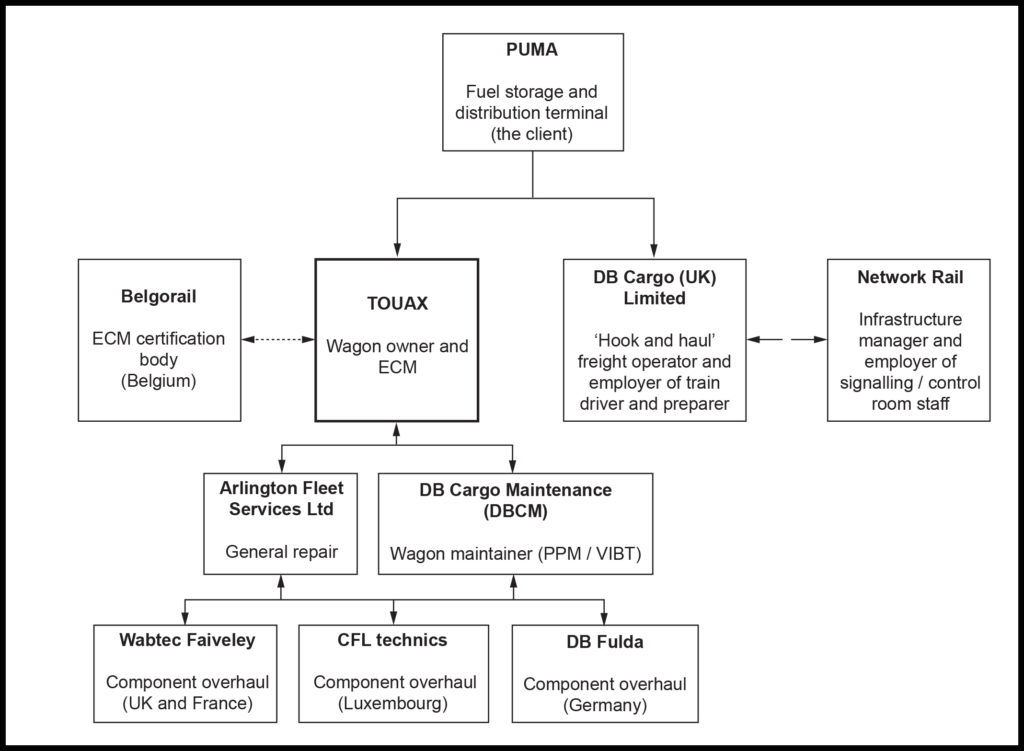
Broadly, this requires the maintenance of a vehicle in accordance with: (i) maintenance file for that vehicle; (ii) applicable maintenance rules; and (ii) applicable Technical Specifications for Interoperability. ECMs must also comply with the common safety method (CSM) for monitoring risk evaluation and assessment.
The maintenance management deficiencies identified in the report were:
- Wabtec Faiveley had no record of its brake control maintenance documents being supplied to or requested by Touax when it took ownership of the wagons in 2015.
- Neither Touax, DBCM nor ASDL identified that these documents were missing from its library. Its maintenance file was therefore deficient as it did not include manufacturer’s instructions.
- Liaison between Touax and DBCM and ASDL was ineffective with no discussion of maintenance problems, such as fitting ‘O’ rings or best practice such as marking nuts to highlight movement between examinations.
- During maintenance, some loose relay valves had been found but this was not reported to Touax or other contractors.
- Touax’s response to previous incidents showed that it was not effectively applying its procedure to learn from accidents.
- There had been many instances of near misses reported but there was no evidence of investigation or corrective action.
- Belgorail’s accreditation of Touax as an ECM appeared to have been based on a survey of management paperwork rather than an examination of work done versus work required. RAIB concluded that regulatory oversight of wagon maintenance was significantly diminished after the ORR relinquished its responsibilities as an ECM certification body
No HABD alarm
While the causal factors identified by the report are primarily concerned with wagon maintenance, the report also concluded that this accident could have been prevented had the Hot Axle Box Detector (HABD) at Pembrey been configured to alert the signaller of the wagon’s dragging brakes.
This HABD, which the train passed over 14 minutes before it derailed, had sensors to measure both wheel bearing and tread temperatures. It had been in use since the 1980s, but its measurement of wheel tread temperatures had caused many false alarms (e.g., from hot wheels due to a train braking heavily) and so its wheel tread temperature alarm was disabled on this class of HADB in 2001.
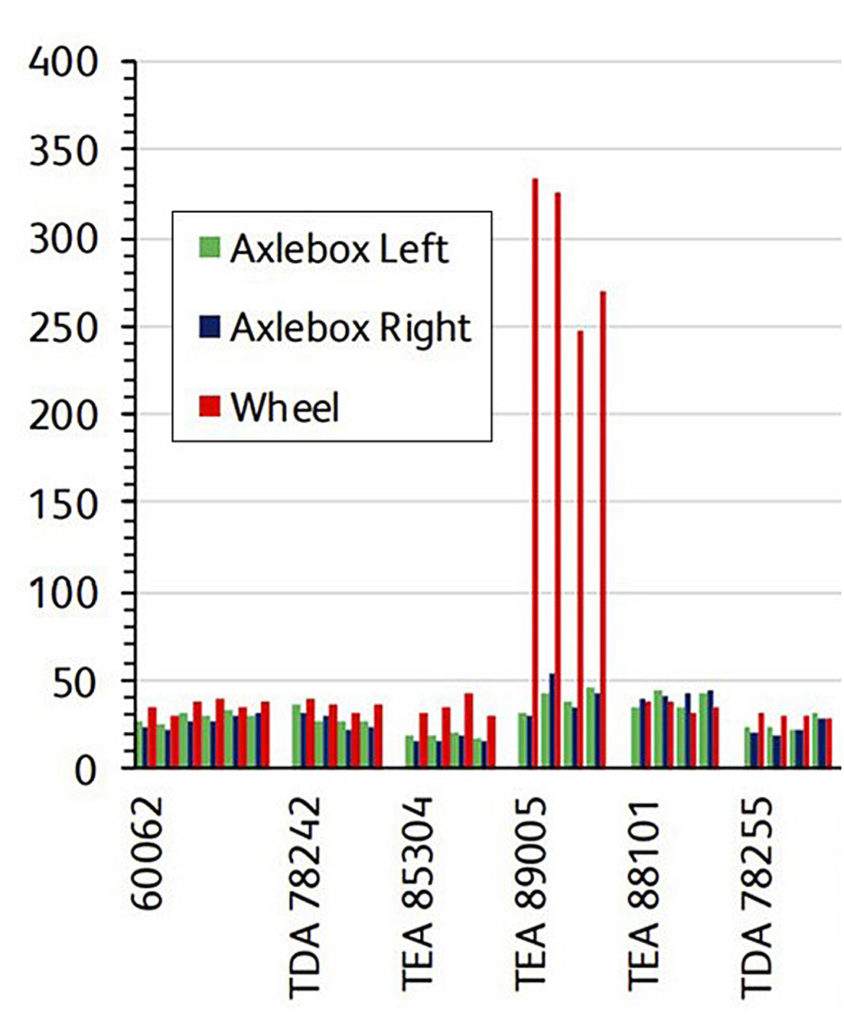
However, when the train passed over this HABD it recorded the leading wheelset of wagon GERS 89005 having a tread temperature of 334°C and the following wheelsets on this wagon having temperatures of 326°C, 248°C, and 270°C, compared with all the other train wheels having temperatures of around 35°C. If all wheels on just one wagon have excessively high temperatures, this indicates an uncommanded brake application on the wagon. Furthermore, the temperature/time curve of the first wheelset as it passed over the sensor indicated that it was a locked wheel with an uneven temperature around the wheel tread.
This, and previous accidents, have shown that dragging wagon brakes present a significant risk. Despite this, the Pembrey HABD had sensors that detected hot wheel treads but did not have the software to raise an alarm. Thus, this HABD provided useful information to RAIB after this accident but could not give the signaller an alarm that could have prevented the accident.
A thorough report
The Llangennech derailment was an extremely serious incident likely to cost tens of millions of pounds. Fortunately, no one was killed or injured, though the line was closed for six months to repair the severely damaged track and remove 31,000 tonnes of contaminated land. Had it occurred close to a population centre and involved more volatile fuel, the direct human consequences could have been considerably worse.
This was a complex investigation, no doubt hindered by evidence being altered or destroyed by the fire. As usual, RAIB has produced a thorough report which makes no less than nine detailed recommendations to address the many deficiencies found. Commenting on this, and previous freight train accidents, RAIB’s Chief Inspector, Simon French, made the following hard-hitting comments:
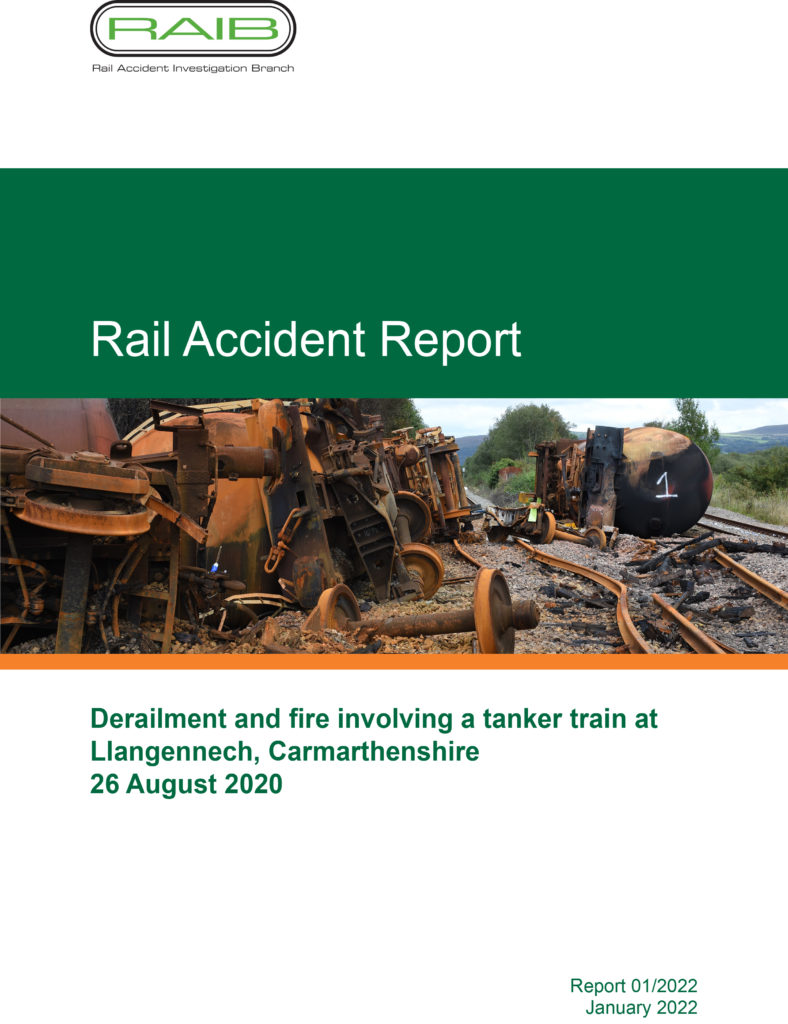
“The rail industry’s approach to the safe maintenance of freight wagons needs to improve. In this investigation we found that there were inadequate maintenance practices, and a failure to appreciate the importance of the correct fastening of the various components of the tanks wagons’ braking system. This is not the first time that we have investigated an accident where RAIB has identified serious issues with the maintenance of a freight train. Over the last decade we have identified deficient wagon maintenance as a factor in more than ten investigations, including maladjusted suspension, undetected frame twist and worn bogie pivot liners.”
With the experience of the pandemic and the carbon benefits of rail (even diesel powered) the future is bright for rail freight. Rail Engineer hopes that the letter and spirit of the RAIB recommendations will lead to the necessary changes.
Recommendations made by the RAIB Llangennech report are summarised below.
Wagon maintenance
- Touax should commission an independent review of actions it has taken to improve management of maintenance following the accident at Llangennech.
- Touax, in conjunction with its routine maintenance supplier, DBCM, should conduct a task analysis of fuel tank wagon maintenance processes at Robeson Terminal, which considers the risks of tasks completed incorrectly and the working environment, and implement the findings.
- AFLS, in conjunction with Touax, should improve its quality management arrangements for maintaining and overhauling safety critical systems and components at Eastleigh Works, including a task analysis of the processes for verifying the work done and that the instructions issued to staff are complete, suitable, and implement the findings.
Relay valve design
- Wabtec Faiveley should use the findings of this investigation to review the design of the interface between the relay valve and the pipe bracket, and implement any necessary improvements.
Role of ECM
- BELAC should use the findings from this report to review its processes to assess certification bodies which apply for or undertake ECM surveillance and certification process. This may also apply to the UK Accreditation Service (UKAS).
- RSSB, with the National Freight Safety Group (NFSG) and UK accredited ECMs, should commission guidance on the practical application of ECM regulations in the freight sector. This should provide ECMs with good practice examples for all four ECM functions, particularly in respect of outsourced maintenance delivery activities.
- The Department for Transport and the ORR should jointly review the current arrangements for the oversight of ECMs and certification bodies that are not based in the UK.
HABDs
- Network Rail, RSSB, and NFSG should review system used in UK and Europe to provide alerts of a wagon defect that may lead to a derailment.
Improving wagon maintenance
- National Freight Safety Group and the Freight Technical Committee, in conjunction with Network Rail and other industry stakeholders, should develop a comprehensive programme of measures designed to promote the improvement of freight wagon maintenance in the UK.

